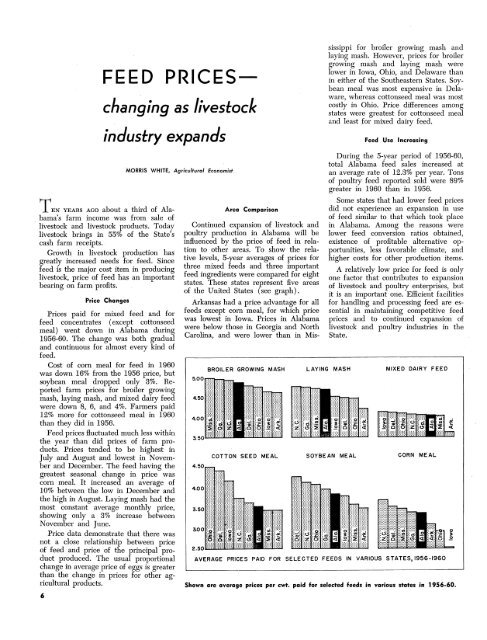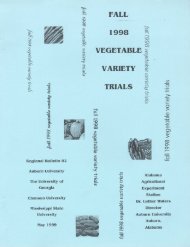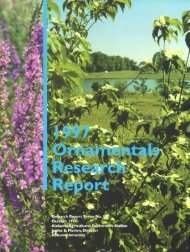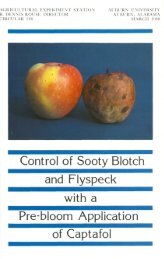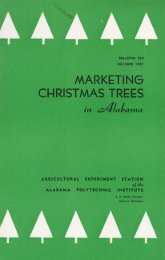Fall - Auburn University Repository
Fall - Auburn University Repository
Fall - Auburn University Repository
Create successful ePaper yourself
Turn your PDF publications into a flip-book with our unique Google optimized e-Paper software.
FEED PRICES<br />
changing as livestock<br />
industry expands<br />
TEN YEARS AGO about a third of Alabama's<br />
farm income was from sale of<br />
livestock and livestock products. Today<br />
livestock brings in 55% of the State's<br />
cash farm receipts.<br />
Growth in livestock production has<br />
greatly increased needs for feed. Since<br />
feed is the major cost item in producing<br />
livestock, price of feed has an important<br />
bearing on farm profits.<br />
Price Changes<br />
Prices paid for mixed feed and for<br />
feed concentrates (except cottonseed<br />
meal) went down in Alabama during<br />
1956-60. The change was both gradual<br />
and continuous for almost every kind of<br />
feed.<br />
Cost of corn meal for feed in 1960<br />
was down 16% from the 1956 price, but<br />
soybean meal dropped only 3%. Reported<br />
farm prices for broiler growing<br />
mash, laying mash, and mixed dairy feed<br />
were down 8, 6, and 4%. Farmers paid<br />
12% more for cottonseed meal in 1960<br />
than they did in 1956.<br />
Feed-prices fluctuated much less within<br />
the year than did prices of farm products.<br />
Prices tended to be highest in<br />
July and August and lowest in November<br />
and December. The feed having the<br />
greatest seasonal change in price was<br />
corn meal. It increased an average of<br />
10% between the low in December and<br />
the high in August. Laying mash had the<br />
most constant average monthly price,<br />
showing only a 3% increase between<br />
November and June.<br />
Price data demonstrate that there was<br />
not a close relationship between price<br />
of feed and price of the principal product<br />
produced. The usual proportional<br />
change in average price of eggs is greater<br />
than the change in prices for other agricultural<br />
products.<br />
MORRIS WHITE, Agricultural Economist<br />
Area Comparison<br />
Continued expansion of livestock and<br />
poultry production in Alabama will be<br />
influenced by the price of feed in relation<br />
to other areas. To show the relative<br />
levels, 5-year averages of prices for<br />
three mixed feeds and three important<br />
feed ingredients were compared for eight<br />
states. These states represent five areas<br />
of the United States (see graph).<br />
Arkansas had a price advantage for all<br />
feeds except corn meal, for which price<br />
was lowest in Iowa. Prices in Alabama<br />
were below those in Georgia and North<br />
Carolina, and were lower than in Mis-<br />
45Oune~ b H pIIe flfe i<br />
tion<br />
BROILER<br />
ares.Tosho<br />
GROWING MASH<br />
te<br />
LAYING MASH MIXED DAIRY FEED<br />
5.00<br />
toiii olhe<br />
4.00 1A .2<br />
li:0<br />
i.5L_. i...:.<br />
4.50:<br />
4.00<br />
3.50<br />
COTTON SEED MEAL SOYBEAN MEAL CORN MEAL<br />
0~o oZOi; ° oZ0O4<br />
sissippi for broiler growing mash and<br />
laying mash. However, prices for broiler<br />
growing mash and laying mash were<br />
lower in Iowa, Ohio, and Delaware than<br />
in either of the Southeastern States. Soybean<br />
meal was most expensive in Delaware,<br />
whereas cottonseed meal was most<br />
costly in Ohio. Price differences among<br />
states were greatest for cottonseed meal<br />
and least for mixed dairy feed.<br />
Feed Use Increasing<br />
During the 5-year period of 1956-60,<br />
total Alabama feed sales increased at<br />
an average rate of 12.3% per year. Tons<br />
of poultry feed reported sold were 89%<br />
greater in 1960 than in 1956.<br />
Some states that had lower feed prices<br />
did not experience an expansion in use<br />
of feed similar to that which took place<br />
in Alabama. Among the reasons were<br />
lower feed conversion ratios obtained,<br />
existence of profitable alternative opportunities,<br />
less favorable climate, and<br />
higher costs for other production items.<br />
A relatively low price for feed is only<br />
one factor that contributes to expansion<br />
of livestock and poultry enterprises, but<br />
it is an important one. Efficient facilities<br />
for handling and processing feed are essential<br />
in maintaining competitive feed<br />
prices and to continued expansion of<br />
livestock and poultry industries in the<br />
State.<br />
0<br />
" :.o o2<br />
AVERAGE PRICES PAID FOR SELECTED FEEDS IN VARIOUS STATES, 1956-1960<br />
Shown are average prices per cwt. paid for selected feeds in various states in 1956-60.


